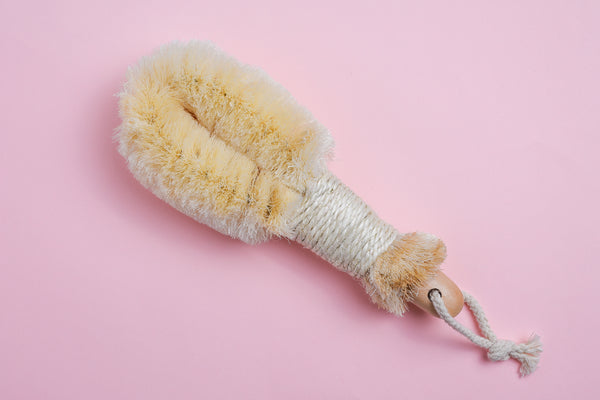We can't find the internet
Attempting to reconnect
Something went wrong!
Hang in there while we get back on track
When you buy through links on our site, we may earn an affiliate commission. Learn more
body scrubbers
By Rachel Geyer
Body Scrubbers
When you think of body scrubbers, colorful, puffy, plastic loofahs are usually what come to mind. What you may not know is that these are not traditional loofahs. The name comes from the loofah plant which has been used as a natural body scrub tool for centuries. Our ancestors used many forms of sustainable body scrub tools, so all you need to do to find a sustainable alternative to today’s synthetic tools is look to the past!
Modern body scrub tools are typically made of plastic, namely nylon, polyester, and polyurethane. Nylon is the most popular as it can easily be manufactured into the net-like material you see in synthetic loofahs, as well as bristles for body scrub brushes.
However, these materials are a type of plastic. Nylon can take 30 to 40 years to decompose. As nylon breaks down, microplastics are released. Even in the shower, microplastics from your nylon tools are washed down the drain. Microplastics are especially worrisome because of their size. Less than 5mm, they are incredibly difficult to clean up and can infiltrate our water, soil, food, and bodies.
Choosing a plastic-free alternative is important, but you should also consider the environmental impact of your showers. Shorter showers can conserve water and energy, as well as money on your water and electricity bills!
Choosing Your Alternative
There are countless naturally sourced alternatives to synthetic body scrub tools; most of them have been used for centuries! We’ve looked at four materials commonly used as scrubbers, some soft enough to use on your face!
Loofah may be the most well-known alternative. Used by the ancient Egyptians for food and shoes, it is still eaten today and used as a household and body scrubber. Rough when dry, loofah sponges soften and expand when wet and become a great exfoliator.
One of the best things about loofah is that it is easy to grow! Closely related to cucumbers, they grow as gourds in relatively warm climates. In the US, it can be grown in zones 5-11 on the USDA Plant Hardiness Zone Map. To make sponges, loofah is harvested in the fall when the gourd is brown and dry. Cut off both ends of the gourd and shake out the seeds – don’t forget to save the seeds so you can grow more! Soak the gourd in fresh water until you can peel off the outer skin. You’re left with a fibrous material to cut into sponges!
Sisal comes from agave leaves and is used in rugs, ropes, accessories, and body scrub tools. The fiber is incredibly strong and makes for a great exfoliator. It can also be made into bristles as an alternative to nylon scrubbing bristles.
Konjac is an Asian plant that has been used for food and beauty products for centuries. Firm when dry, sponges made of konjac expand and soften when wet. They still function as an exfoliant but are much softer than loofah and sisal. Historically it has even been used to clean a baby’s skin. Plantish Future is just one company that sells konjac sponges, but they take their sustainable efforts a step further by selling konjac sponges misshapen from transportation for 50% off instead of throwing them away.
Sponges are a kind of underwater animal with almost 9,000 recorded species. Some sea sponges have been used commercially for thousands of years. Bath sponges were only one use, but sea sponges can still be used as bath sponges today. Harvested sustainably, sea sponges are a good alternative to synthetic body scrub tools and sponges. Along with konjac, they are very gentle on your skin.
All four of these materials come directly from a plant or animal and can be fully composted in your backyard. Now that you know how to dispose of your scrubber, it’s also important to know when to do so. These body scrub tools, synthetic or natural, are the perfect environment for bacteria. You should make sure to store your scrubber in a dry location after use to reduce this risk, but after a certain amount of time, you’ll need to dispose of it. Suggested use periods vary by product, so be sure to check.
Sources
- https://ecomaniac.org/biodegradable-loofah/
- https://www.xometry.com/resources/materials/uses-of-nylon/
- https://www.sciencelearn.org.nz/resources/1543-measuring-biodegradability
- https://www.ncbi.nlm.nih.gov/pmc/articles/PMC9412705/
- https://www.epa.gov/sites/default/files/2017-02/documents/ws-ourwater-shower-better-learning-resource_0.pdf
- https://ngb.org/growing-and-enjoying-luffa-sponges/
- https://www.epicgardening.com/growing-luffa/
- https://planthardiness.ars.usda.gov
- https://shoutlearning.org/the-eco-friendly-benefits-of-sisal.html
- https://sustainabilitynook.com/are-konjac-sponges-eco-friendly/
- https://oceanservice.noaa.gov/facts/sponge.html
- https://onlinelibrary.wiley.com/doi/full/10.1111/j.1439-0485.2008.00235.x
- https://onlinelibrary.wiley.com/doi/10.1111/j.1365-294X.2011.05222.x
- https://health.clevelandclinic.org/loofahs-can-double-as-bacterial-breeding-grounds/
Want more? Become an Intentful Consumer!
Get updates on new research and products. Upvote, comment, and add suggestions to help others.




